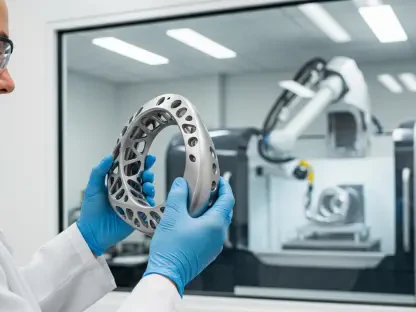The biopharmaceutical sector, a cornerstone of global health, is grappling with a troubling decline in resilience, as evidenced by recent industry surveys capturing the views of over 1,000 executives worldwide. With mounting pressures on manufacturing agility and regulatory frameworks, the ability to deliver life-saving therapies hangs in a delicate balance. Supply chain disruptions and talent shortages further complicate the landscape, raising urgent questions about the industry’s capacity to adapt. This roundup dives into diverse perspectives from biopharma leaders and stakeholders, exploring the critical challenges and potential solutions shaping the sector’s future. By synthesizing opinions and strategies from multiple sources, the aim is to provide a comprehensive overview of where the industry stands and how it can navigate these turbulent times.
Exploring the Decline in Biopharma Fortitude
Manufacturing Bottlenecks Stifle Growth
Insights from global industry surveys reveal a near-unanimous concern among executives about manufacturing agility, with many pointing to persistent delays in scaling production for cutting-edge therapies like mRNA vaccines and cell treatments. A significant portion of leaders—roughly one-third—notes that their organizations struggle with slow ramp-up times, creating bottlenecks that hinder the timely delivery of innovative drugs to market. This issue is particularly acute for complex biologics, where standardization across new modalities remains elusive.
Differing views emerge on how to address these challenges, with some stakeholders advocating for increased reliance on contract development and manufacturing organizations (CDMOs). Reports indicate that over half of surveyed companies have ramped up partnerships with CDMOs, citing improvements in speed and quality. However, others caution that outsourcing alone cannot solve deeper systemic issues, such as the need for in-house expertise and infrastructure investment to ensure long-term scalability.
A third perspective highlights the tension between cost efficiency and product integrity, with a substantial 40% of industry voices warning that prioritizing savings often compromises quality. This debate underscores a broader strategic dilemmwhether to focus on short-term financial gains or invest in robust processes that safeguard patient outcomes. The consensus leans toward a balanced approach, though actionable steps remain a point of contention among leaders.
Supply Chain Gains Amid Hidden Vulnerabilities
On a brighter note, many industry insiders praise recent strides in supply chain resilience, with more than half of surveyed executives reporting enhanced visibility and efficiency through digital tools. The integration of analytics and automation has streamlined operations, allowing companies to respond more swiftly to disruptions. This progress is seen as a critical buffer against the unpredictable nature of global trade and logistics.
However, not all perspectives are optimistic, as some leaders point to underlying risks that digital advancements cannot fully mitigate. For instance, sourcing challenges for advanced therapies remain a sticking point, compounded by geopolitical volatility. A notable trend, supported by 56% of respondents, is the shift toward domestic biologics manufacturing to reduce reliance on international supply chains, though opinions vary on whether this approach can be scaled effectively across regions.
A contrasting viewpoint emphasizes the looming threat of trade uncertainties, with three-quarters of executives anticipating significant impacts on global strategies. While regional sourcing offers a potential shield, skeptics argue that it may introduce new complexities, such as higher costs and limited access to specialized materials. This diversity of thought reflects the intricate balance the industry must strike between resilience and practicality.
Regulatory Hurdles Slow Innovation
Government policy and regulation draw sharp criticism across the board, with over half of biopharma leaders identifying inconsistent frameworks as a primary barrier to progress. This sentiment has grown in recent years, as fragmented policies across regions create uncertainty for companies developing advanced therapies. Some stakeholders highlight specific pain points, such as delays in clinical trial approvals due to misaligned standards.
Differing opinions surface regarding the impact of specific regulatory changes, like updates to user fee acts in certain markets aimed at streamlining processes. While a segment of executives views these reforms as a step forward, others argue that restrictive price controls and potential tariff increases—expected by 56% of respondents—offset any gains. This split reveals a broader frustration with the pace of global harmonization efforts.
A third angle questions whether current regulatory systems are equipped to handle the rapid evolution of biopharma innovation. Many leaders express doubt, suggesting that without a unified approach, the industry risks stifling breakthroughs in areas like gene therapy. The debate continues on how to advocate for policies that balance safety with speed, with no clear consensus on the best path forward.
Talent and Sustainability Challenges Loom Large
Skill shortages in high-growth fields like gene therapies are a recurring concern, with nearly 40% of industry voices reporting critical gaps that impede development. The struggle to attract and retain talent in specialized areas is compounded by a perceived lack of supportive government policies for workforce scaling. Some executives point to digital training platforms as a solution, noting higher success rates among firms that adopt these tools.
Sustainability presents another layer of complexity, with almost half of surveyed leaders admitting to missing environmental targets amid financial pressures. Opinions diverge on prioritization, with high-performing companies viewing green practices as a driver of long-term value, while others see them as secondary to immediate operational needs. The role of analytics in tracking energy use and waste reduction is often cited as a differentiator for those achieving better outcomes.
A contrasting perspective focuses on the cultural shift needed to address both talent and sustainability issues. Some stakeholders argue that fostering a workplace environment that values continuous learning and environmental responsibility could redefine competitive advantage. However, skepticism persists about whether such changes can be implemented at scale without significant policy and financial backing from industry and regulators alike.
Strategic Directions and Industry Consensus
Synthesizing the range of opinions, it becomes clear that manufacturing delays and regulatory inconsistencies are the most pressing drags on biopharma resilience, though supply chain improvements and R&D advancements offer hope. Many leaders agree on the need for deeper partnerships with CDMOs to alleviate production bottlenecks, with a growing emphasis on digital tools to enhance scalability and efficiency across operations.
Divergent strategies emerge in other areas, such as the push for regional sourcing to counter global risks, which some view as essential and others as a costly compromise. There is also a shared call for advocacy to align policies internationally, though approaches vary on how to engage with policymakers. Practical tips from top performers include leveraging artificial intelligence for production optimization and investing in workforce upskilling to bridge talent gaps.
A balanced perspective suggests that no single solution will suffice, and the industry must adopt a multifaceted approach. Combining technology adoption with strategic collaborations and policy reform appears to be a common thread among successful firms. This roundup of insights highlights the complexity of the challenges at hand while pointing to actionable ideas that could steer the sector toward greater stability.
Reflecting on the Path Traveled
Looking back, the discussions among biopharma leaders painted a vivid picture of an industry at a crossroads, wrestling with systemic weaknesses while uncovering pockets of innovation. The varied opinions on manufacturing, regulation, and sustainability revealed both the depth of the struggles and the potential for transformative change. Moving forward, stakeholders should prioritize investments in scalable technologies and advocate for streamlined regulatory frameworks to rebuild resilience. Exploring partnerships that bridge talent gaps and incentivize sustainable practices could also prove vital. As the sector continues to evolve, staying attuned to emerging digital tools and regional strategies will be key to ensuring access to critical therapies for patients worldwide.









